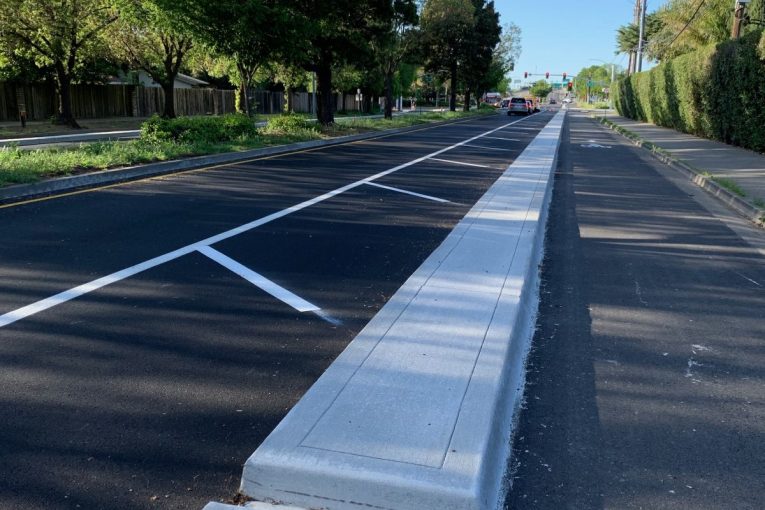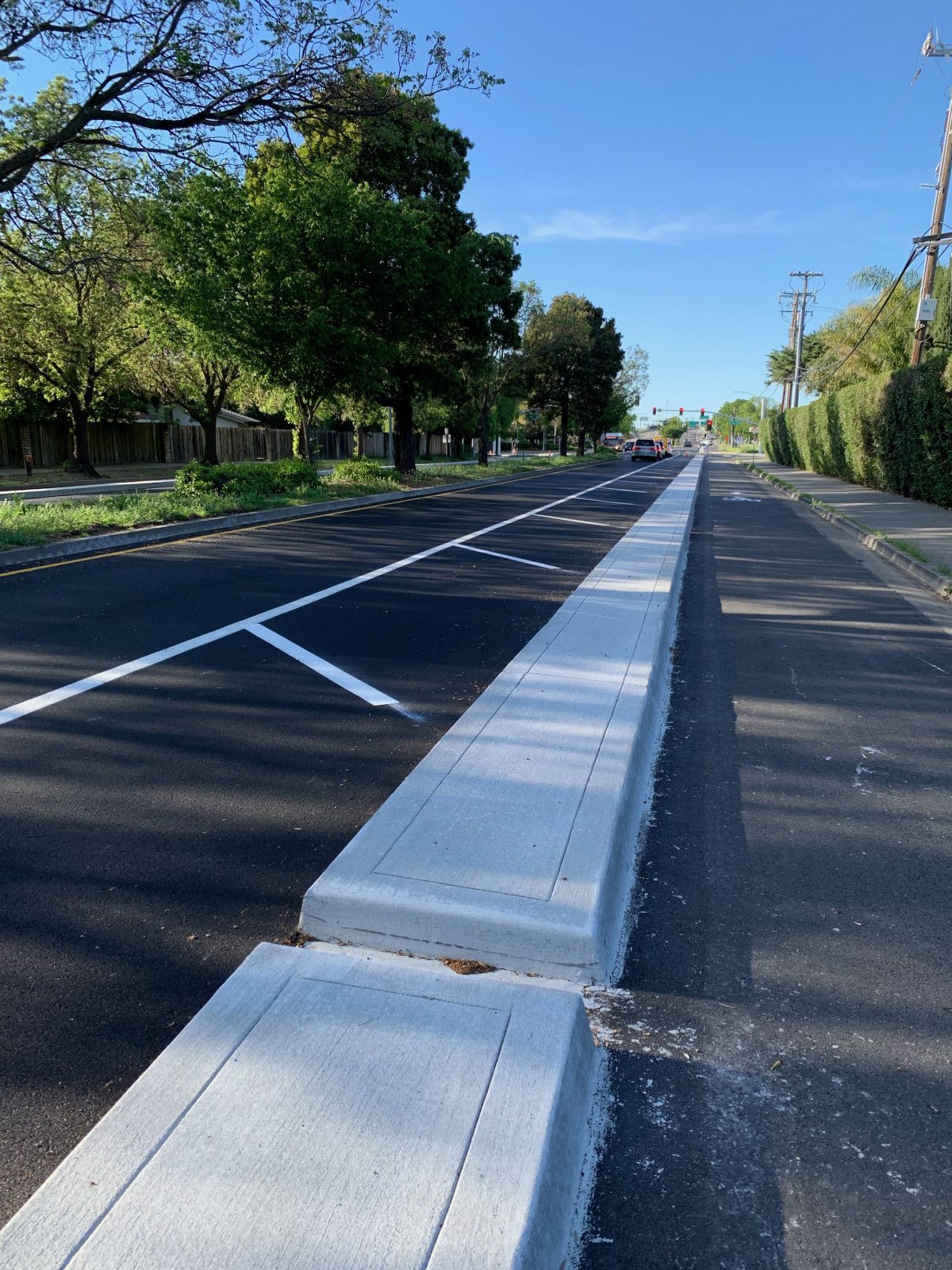

Prior to spring break, I picked up my 9th grader just after 5 pm on a Thursday evening, hit a wall of traffic at the inflection point on the Mace Curve and sat in traffic for half an hour as we slowly and painfully inched toward the Mace overpass, and eventually the traffic flow freed up after the eastbound on-ramp.
I cite this story because that traffic back up had nothing to do with the redesign but illustrates that there were traffic conditions on I-80 that were causing this problem – not road work on Mace.
On Thursday, I did the same trip at the same time and it was normal, largely free-flowing traffic with minimal congestion. From my vantage point, northbound Mace looked about normal. There was back up on the eastbound on-ramp, but nothing out of the ordinary.
Moreover, I received photos from others along northbound Mace that showed a whole bunch of nothing.
City staff acknowledges that a good portion of the problem is the traffic on the I-80 corridor and the Waze and other apps, and is completely out of their hands. In fact, they go further than that by acknowledging that, given the algorithms and true causes of the problem, efforts to increase capacity “may not endure” and perhaps may backfire.
If these problems are only occurring at certain times of the year, perhaps we need to hit the pause button, take a longer view, and figure out a real and long term solution before we plop down another half million dollars for a fix that does not appear necessary or urgent at this time.
Part of the problem here is that city staff and by extension the council are responding to public outcry. We get that. But public outcry is reacting to things that are not occurring in present  time. A certain number of residents decided there was a problem with the road design and you cannot convince them otherwise, even as data and facts now show an entirely different picture.
time. A certain number of residents decided there was a problem with the road design and you cannot convince them otherwise, even as data and facts now show an entirely different picture.
Moreover, while 200 people showed up last week at the city’s meeting at the South Davis fire station, that represented really one demographic. There was an absence of other participants. Parents with school children – whose children attend Pioneer – were not at this meeting.
Given that the situation is no longer grave or calls for immediate response, perhaps the wise course would be to take a deep breath, study the problem, and come up with a long term solution that is actually a solution.
The troubling thing is that the staff report makes us very aware that staff understands the drawback of the approach here.
A different picture is emerging from the one that clearly is seared in the eyes and minds of many residents from February and March.
The new picture shows that, while there remain back ups on I-80 and in parts of town due to heavy commutes on Thursdays and Fridays, this congestion is no longer spreading as heavily onto Mace.
This picture confirms what I believed already – the cause of the traffic back up was the traffic on I-80, not the structure of Mace.
At the same time, it is clear from city staff analysis that there are design features that need to be corrected, and I fully support doing that.
My problem is that going back to four lanes is probably not going to solve the problems during those times when the eastern portion of town became a parking lot. And there is even troubling evidence it could make the problem worse.
Staff writes that they believe the project itself has likely contributed to congestion, both through the construction work and some of the design features – including the reduction from four to two automobile traffic lanes and the removal of right turn lanes at the Mace and Cowell intersection.
But where is the data to support that contention?
Moreover, there is a lack of discussion of prior traffic impacts.
We know from 2017 that these problems were occurring anyway – and they might have actually been worse in 2017, it’s simply that there was no road construction, so there was not much that could be blamed on the city.
Staff writes: “Traffic congestion on Interstate 80 continues to increase, as does the use of navigation applications diverting drivers around it. This technology has also affected Cowell Blvd, Covell Blvd, and Second Street corridors. Given navigation applications algorithms route drivers based on travel time, peak traffic congestion relief from capacity-increasing design revisions may not endure, long term.”
Staff warns that “routing more cars through the corridor may occur, resulting in similar congestion problems.”
If that’s the case, why are we solving a problem that we do not currently have with a solution that may not work?
City staff, acknowledging this problem, then opines, saying “adjustments to the Mace Blvd corridor should focus on accommodating local traffic demands and movements, while assisting with alleviating out of town ‘cut through’ traffic to the extent possible.”
One thing described by Chief Pytel was the idea of providing a lane to act as a queue for traffic going onto Mace while leaving the other lane clear for through traffic. This doesn’t accomplish that.
In fact, I can point people to the problem from Harper to the eastbound on-ramp on southbound Mace. What happens is that both lanes are congested until you get past the on-ramp. Why? Because traffic that is headed for the on-ramp will move to the left lane and then attempt to merge at the last minute – which actually adds to the traffic congestion.
Creating two travel lanes then does little to solve the congestion. If, however, you separated the two lanes physically so that traffic couldn’t merge from one to the other, then you might be able to alleviate things for traffic that is staying local.
But Alternative 1 doesn’t do that. It simply perpetuates the same design flaw that existed before any of this was contemplated, and exists in the southbound direction.
Besides, if the problem is caused on both ends by traffic congestion on I-80, we are simply rearranging the deckchairs on the Titanic.
Staff argues that the ultimate solution is to increase capacity of I-80 or “other policies to bring highway travel in better alignment with capacity. Separate efforts with Caltrans are underway to examine this issue more closely.”
Davis has two bottlenecks – the constraining of travel lanes from six to three right before Richards Blvd. and the inflow of traffic at Mace, and also the leading to back up at the levee as traffic enters the three-lane causeway. Eliminating one of the lanes at UC Davis, having a dedicated exit lane at Richards, and adding a fourth travel lane on the causeway would go a long way toward alleviating these bottlenecks.
In the meantime, apps are re-routing traffic onto county roads at Pedrick, bypassing I-80 and contributing to the back up at Mace.
This leads staff to also warn that, because of the algorithms, freeing up capacity on Mace may actually result in more traffic being routed through the corridor rather than less.
This discussion, therefore, leads me to two conclusions.
First, this “solution” may make things worse, not better and, therefore, second, we may want to re-think this as a fix.
To me this is an overreaction to public pressure and the biggest problem is that it seems aimed at quieting that criticism – rather from any probability the efforts will actually solve the problem when the worst traffic conditions re-emerge.
Instead, the city seems to want to be able to say that we did our part, this is out of our hands, and have the majority of the citizens end up basically agreeing.
The problem is this seems more like a political solution than a workable fix for Mace.
—David M. Greenwald reporting







“In the meantime, apps are re-routing traffic onto county roads at Pedrick, bypassing I-80 and contributing to the back up at Mace.”
What if we add a long traffic light at Mace and Montgomery, and Danbury and Montgomery against cars entering Davis? The purpose of the traffic light is to limit the number of cars that can enter Davis during rush hours.
If the light is on, every time the light turns green, one car may enter Davis. The on hours of the light is either based on a set timer or remotely controlled based on congestion on Mace Blvd. The intended effect is to limit the impact of Waze routing non-local traffic into local streets.
Cheaper, and more effective to sign all streets in Davis to be one-way… all out of town. Could make exceptions for emergency vehicles. Many problems solved…
Could you clarify? Why all streets “IN” Davis? Do you mean that if I start my car anywhere in Davis I can only drive out of Davis?
Or do you just mean that all country roads only exit Davis, and the only way to enter Davis is through 113 or I80? So if a car got out of Davis, they can only enter by queuing on the highways.
I would encourage the council to actually evaluate the system rather than react to the angry voices in the room.